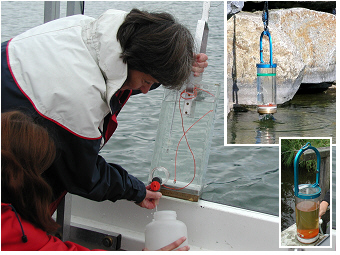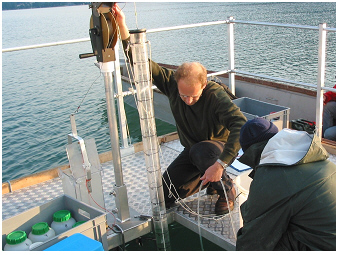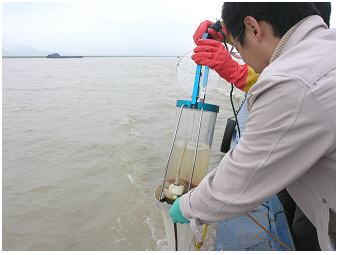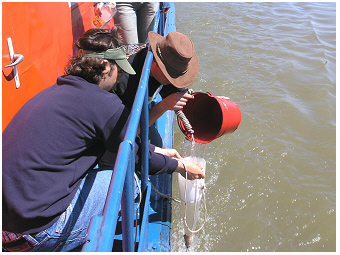About some methods investigating freshwaters
field sampling methods
 Lake Mondsee, Austria, 2000
Lake Mondsee, Austria, 2000
(insets - top:
swimming pond, Austria, 2006; bottom: Bergknappweiher, Germany, 2001):
Various types of water sampler to take samples from certain depths are
shown here. SCHINDLER sampler is displayed in the main photo (left,
named after the Canadian limnologist D.W. Schindler),
UWITEC
water samplers in both insets. These samplers are operated in
the open position when lowered down-flow
to
the sampling depth. The hinged-lid on top and bottom of the sampler
seals when the water flow is turned upward to move the sampler
back to the surface and provides thus the sample taken from a certain
water
depth.
The commonly known ‘RUTTNER sampler’ - this standard water
sampler
is named after the Austrian limnologist
F. Ruttner - looks similar to the UWITEC water sampler
shown here,
but is closed at a cetrain sampling depth by a falling weight.
Other
water samplers are even successively filled up when left gradually the
water column down. These are depth-integrated samplers, which can be
operated
mechanically. During lowering the sampler, the container enlarges while
moving the lid by a smooth operated chain and water flows successively
in the sampling container with increasing depth (syringe-like operated
water sampler). Other constructions of depth-integrated samplers are
built by a pear-shaped glass
bottle, which is gradually filled up with depth by underwater pressure
balance (SCHRÖDER sampler, named after the German Limnologist R. Schröder). Lake Mondsee, Austria,
2002:
Lake Mondsee, Austria,
2002:
GERVAIS tube sampler (named here after F. Gervais who is a
German limnologist, see
'close-interval tube sampler of 2 m height' in Gervais 2003 R).
This
particular tube
sampler can be used for taking an
integrated
sample over a
water column of 2 m in certain vertical depths,
e.g. in
the epilimnion,
metalimnion or hypolimnion. It further has the advantage to take
sub-samples within
the 2 m water column of the tube. The photo shows the
use of this tube
sampler during the workshop of ‘high-resolution measurements in space
and time in Mondsee on
plankton community’ (‘HighMoon’). A simple crane connected with a
winch
can also be seen on the photo. Winches and calibrated ropes or cables
are commonly used for depth profiling to operate samplers and
multiparameter meters.
Tube samplers are also common for taking depth-integrated samples from
the top surface layer of shallow lakes. Such simple but precise and
reliable
working water-surface sampler is just a 1.5 m plastic tube and can be
easily operated by hand and without the use of winches. The tube is
lowered
vertically into the water
until it is filled up with water. After the tube is sealed on the upper
side with a rubber stopper by hand, it can be pulled out of the water.
The tube needs then to be emptied immediately into a prepared sampling
container - just by a slight lift-up of the rubber stopper.
On this the freshwater page, some methods used for field sampling or
lab treatment will be described. Sampling and also treatment refer
mainly to the phytoplankton and related issues as always on this
website.
For this reason, the procedure of counting phytoplankton
from the
water
sample will be included. Besides a more detailed description of some
phytoplankton taxa, a list of the cell dimensions of common
phytoplankton species will be provided.
Topics related to the
sampling procedure are described in the
Preface
S
and on pages about lake Mondsee
S
and pond
Bergknappweiher
S
of the
lakeriver-website.
An appropriate sampling concept is the first step to
finally get reliable data assessing an ecosystem.
volume
According to a governmental initiative in Ireland, just to give the
reference from one country, volunteers
were
encouraged doing surveys in streams and lakes in their close
neighborhood (sampling and bio-monitoring). Such a
campaign
can indeed help to regenerate a wide-spread and reliable
monitoring information of the current water quality in nature. In
turn, local
people could benefit too and become more aware of the surrounding
nature
in this way. Far from such campaigns also individual people can be
interested to investigate their own wildlife
pond
S
in the garden, their
larger basins of a ‘natural’ swimming
pond
S
system or the wildlife Wood pond
S
and
lake nearby in
the meadow. Valuable information about the water quality can indeed
be gathered by a rather simple
scheme of easy to measure parameters
that are recorded in a bi-weekly or monthly sampling interval. Why this
is worth doing, what results can be expected and how to manage the
measurement, will be also explained later on this
page. It is even suggested here to keep such easy monitoring
for
‘wild-life garden-ponds’ as simple as possible, in case of studying
running and stagnant freshwater
ecosystems the methods and concepts of advanced limnology are
strongly recommended.
 Poyang
Lake, China, 2011:
Poyang
Lake, China, 2011:
In addition to regular phytoplankton samples also phytoplankton
net-samples are taken. The water is taken with a water sampler from
a certain depth and is thereafter passed through a plankton net of the
defined mesh
size. In this subtropical lake, gloves must be worn while sampling to
avoid skin contact with the water and hence an infection with parasitic
trematodes (schistosomiasis, bilharzia).
 Danube River, downstream from
Iron Gates, Romania,
2005:
Danube River, downstream from
Iron Gates, Romania,
2005:
An easy way to take a phytoplankton net-sample from surface water. Some
water volume just passes the plankton net of 10 µm mesh size to get
here enough material for microscopy. For many reasons such
'metal-bucket-sampling' would be by far not appropriate for
taking samples for chemical analyses.
During regular sampling, samples are taken with samplers shown in figures above.
Phytoplankton samples are filled into small bottles (100 mL) and fixed with Lugol's solution for preservation.
Later in the lab, the phytoplanktonsamples are quantified by microscopy. Here, algal cell abundance and biovolume
is determined using sedimentation counting chambers under the light microscope. The Phytoplankton biovolume can be converted into fresh biomass.
Both quantitative parameters are used an indicator of the water quality and productivity of a lake
(Teubner et al. 2023, R).
cited References about sampling methods
Teubner K, Dokulil MT, Kurmayer R (2022) Eutrophierung, toxische Cyanobakterien am Beispiel des urbanen Donau-Altarmgewässers Alte Donau und des alpinen Mondsees. In: Mikrobiologie und Wasser. Teil 2: Fallstudien zur Illustration der neuen diagnostisch-analytischen Möglichkeiten. Farnleitner AH, Kirschner AKT, Frick C, Proksch P and Vogl W (Hrsg.), Arbeitsbehelfe Österreichischer Wasser- und Abfallwirtschaftsverband (ÖWAV), Wien, 52(2):35–45 FurtherLink Look-Inside
Gervais F, Siedel U, Heilmann B, Weithoff G, Heisig-Gunkel G & A Nicklisch (2003) Small-scale vertical distribution of phytoplankton, nutrients and sulphide below the oxycline of a mesotrophic lake. Journal of Plankton Research 25(3): 273-278. FurtherLink
Schindler DW (1969) Two useful devices for vertical plankton and water sampling. Journal Fisheries Research Board of Canada 26(7): 1948-1955.
Schröder R (1969) Ein summierender Wasserschöpfer. Archiv für Hydrobiologie 66: 241-243.
Ruttner F & K Herrmann (1937) Über Temperaturmessungen mit einem neuen Modell des Lunzer Wasserschöpfers. Archiv für Hydr 31: 682.
